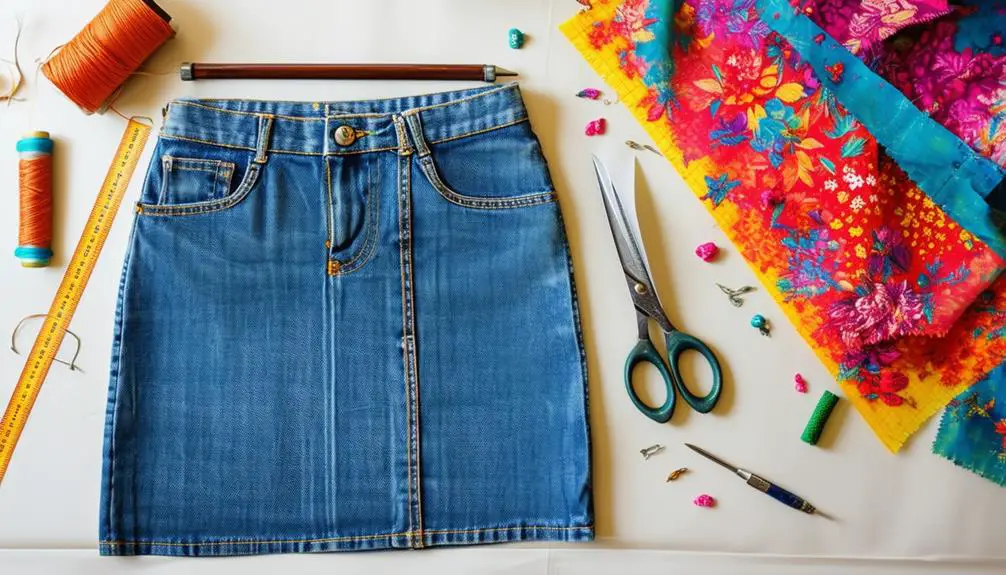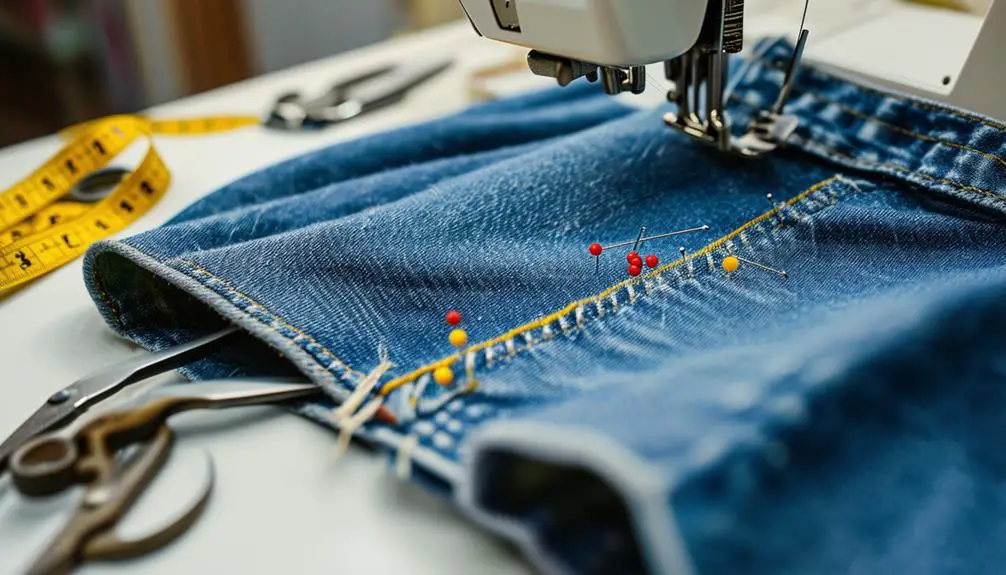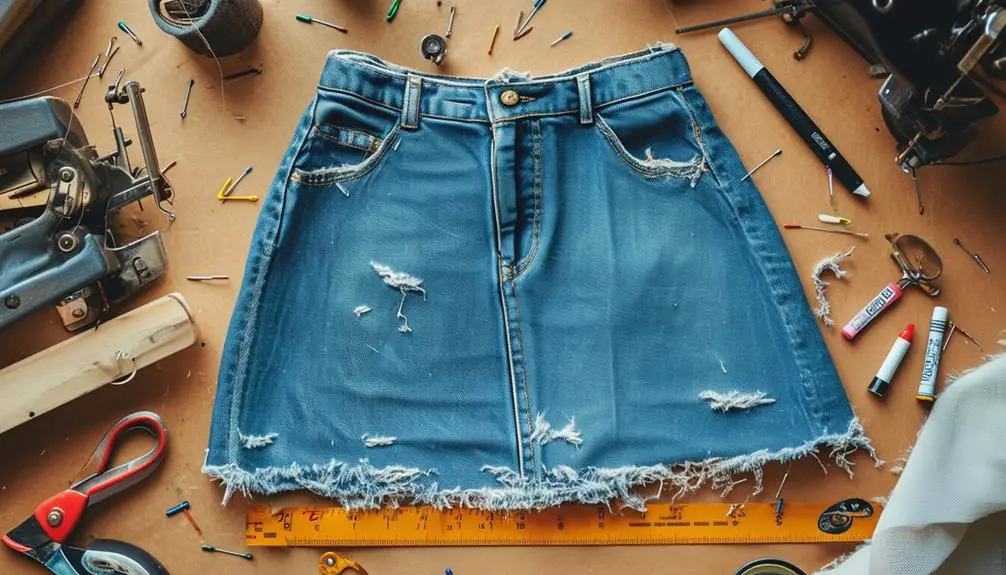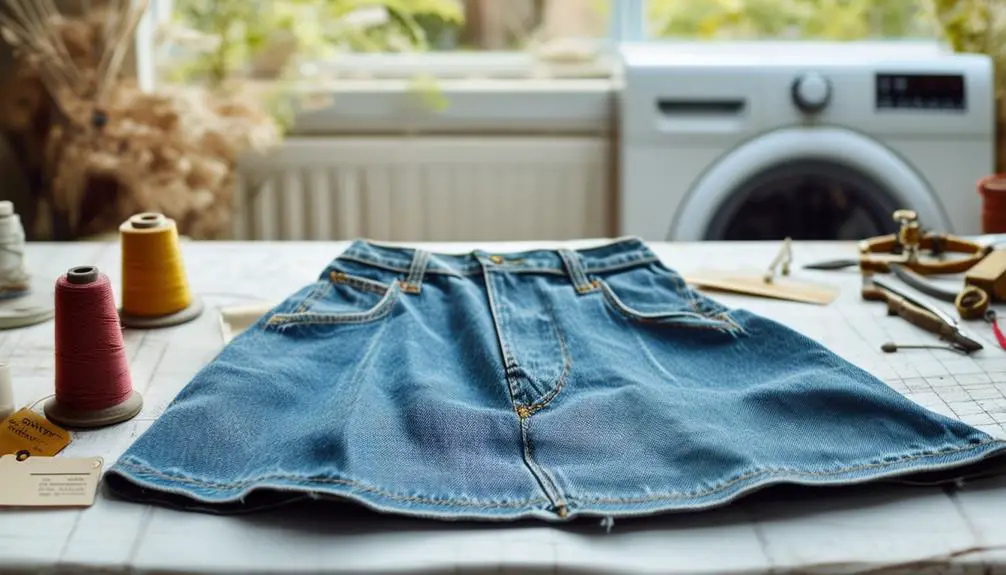To tailor a vintage denim skirt, start by measuring your waist and marking the new size with fabric chalk. Carefully detach the waistband using a seam ripper, and cut it to fit your desired measurements. Reattach the waistband, ensuring it aligns perfectly. Try on the skirt to check for comfort and make any final adjustments. When hemming, opt for the original hem for a professional finish or embrace a frayed edge for a relaxed vibe. With some simple techniques in mind, you can transform your skirt into a trendy staple. Want to explore more tips and tricks?
Materials and Tools Needed

When you're ready to tailor your vintage denim skirt, gathering the right materials and tools is vital for a smooth process. Start with a measuring tape; it's your best friend for accurately gauging the current and desired dimensions of your skirt. You'll want to guarantee every inch is just right, so take your time measuring!
Next, grab a seam ripper. This handy tool is essential for carefully detaching the waistband or any seams without damaging that beautiful denim fabric. It allows you to make changes with precision, guaranteeing your skirt maintains its vintage charm.
A reliable sewing machine is also a must-have. Denim can be thick and tricky, so your sewing machine should be up to the task, providing efficient stitching capabilities.
Don't forget to pick up matching thread in the same color as your denim; this will help create a seamless appearance after your alterations.
Lastly, consider using fabric chalk or pins to mark your measurements clearly. These tools will help you stay precise throughout the tailoring process, making sure your vintage skirt turns out just the way you envision it.
Happy tailoring!
Measuring the Waist
Start by wrapping a measuring tape around the waist of your vintage denim skirt to capture its current circumference. Confirm the tape lies flat and snug but isn't too tight—comfort is key!
Once you have that measurement, it's time to determine your desired waist size. Subtract your ideal waist measurement from the original waist circumference to see how much fabric you'll need to take in.
To keep your alterations precise, mark the new waistline evenly around the entire waistband with fabric chalk or pins. This guarantees that you'll maintain a consistent fit as you work through the tailoring process.
Before you engage, double-check your measurements; even slight discrepancies can lead to an improper fit that's frustrating to fix.
If you can, try the skirt on during this process. Visualizing how it fits can give you a better sense of comfort at the new waistline and help you make any necessary adjustments on the spot.
Tailoring your vintage denim skirt isn't just about fitting—it's about creating a piece that feels uniquely yours!
Removing the Waistband

How do you guarantee a smooth changeover when removing the waistband of your vintage denim skirt? Start by grabbing a seam ripper, your trusty tool for this task.
Carefully detach the waistband from the skirt, ensuring you don't damage the fabric underneath. Begin at one end of the waistband, gently pulling the fabric apart as you cut the threads connecting it to the skirt.
As you work your way around, keep an eye out for any additional stitching or tags that might need to go too; this will help you achieve a clean finish.
Once you've fully detached the waistband, set it aside for reference when cutting a new one to your desired size.
Laying the skirt flat is essential at this stage. Assess the remaining fabric and pin the new waistband securely onto the skirt, ensuring an accurate fit before diving into the sewing process.
This step not only sets you up for success but also amplifies your vintage skirt's style, giving it a fresh and tailored look.
With precision and care, you're one step closer to rocking that personalized denim skirt!
Altering the Waistband
Altering the waistband of your vintage denim skirt can transform it into a perfect-fitting fashion statement. Start by measuring the current waistband size and subtracting the desired size from the original measurement to see how much you need to alter it for an ideal fit.
It's also vital to take into account the unique characteristics of vintage denim, as vintage clothing identification may reveal specific details about the fabric and construction techniques used in your skirt.
Next, grab a seam ripper and carefully detach the waistband from the skirt, taking care not to damage the fabric. Keep the removed pieces handy; they'll be helpful during your alteration process.
Once you've got the waistband off, cut it to your new desired size, remembering to factor in any seam allowances for reattachment.
With your measurements in hand, pin the altered waistband back onto the skirt, making sure it aligns perfectly and that the fabric is evenly distributed around your waist. This step is essential for achieving that polished look you want.
After you've sewn the waistband back on, try on the skirt to verify it fits just right. Make any necessary adjustments before finishing the seams and giving everything a good press.
With these steps, your vintage denim skirt will be tailored to fit like a glove!
Final Adjustments

With the waistband securely reattached, it's time to confirm your vintage denim skirt fits just right. Slip it on and check how it sits on your hips. You want it to feel comfortable without any gaps.
If it's too loose or tight, make those final adjustments by loosening or tightening the waistband as needed.
Next, grab your iron and press the waistband. This step not only gives it a crisp finish but also enhances the overall style of your skirt. A polished waistband can elevate your entire outfit.
While you're at it, inspect the skirt for any loose threads or uneven seams. Trim away any imperfections to confirm a neat, professional look.
Hemming Techniques
When it comes to hemming your vintage denim skirt, achieving that perfect finish is vital for preserving its charm and style. One of the best hemming methods is the original hem technique, which maintains the factory edge, giving your skirt a polished look.
Vintage denim often showcases unique characteristics, such as specific fabric types and stitching patterns, that enhance its appeal—identifying vintage pieces. If you prefer a more casual vibe, try leaving some frayed edges; just remember to use a zigzag stitch or a serger to prevent unraveling while keeping it trendy.
Using a sewing machine is important for durability, as it guarantees stronger stitches that can handle thick denim. First, measure and pin the fabric carefully to assure an even hem length all around.
Folding the hem is another popular option—simply fold it up to your desired length and use topstitching to secure it in place. This method not only adds strength but also enhances the aesthetic.
Experiment with different hemming methods to see which one suits your personal style best. Whether you're aiming for a chic finish or a relaxed look with frayed edges, these techniques will help you achieve a tailored, fashionable skirt that reflects your unique taste.
Common Challenges

Sewing a vintage denim skirt can be an exciting project, but it comes with its own set of challenges. One of the biggest hurdles is aligning the waistband during topstitching, especially when you're working with thick denim. You might find that a heavy-duty needle is crucial to prevent breakage and guarantee clean stitches.
Another common issue is achieving even hem lengths around the skirt. Uneven hems can throw off the entire look, making the garment appear unprofessional. To avoid this, take your time to measure and pin carefully before you sew.
When handling thick denim, remember that not all sewing machines are created equal. You'll need one with enough power to handle the fabric without stalling. Additionally, frayed edges can complicate traditional hemming methods, so consider using serging or bias tape for a polished finish.
Lastly, misalignment of seams during the alteration process can lead to an amateurish result. Double-check your measurements and pin everything in place before you cut or sew.
DIY Tips for Beginners
Tackling a vintage denim skirt can feel intimidating, but starting with manageable projects makes all the difference.
Begin by focusing on simple alterations, like hemming the skirt, to build your confidence. Here's how to get started:
- Mark Your Measurements: Use fabric markers or chalk to clearly outline where you'll cut. This guarantees accuracy and prevents any costly mistakes.
- Practice First: Before you alter a denim skirt, practice sewing techniques on scrap denim. Familiarizing yourself with the fabric will help you avoid mishaps on the actual skirt.
- Watch Tutorials: Find online videos that demonstrate various sewing methods. Visual guidance is invaluable and can clarify any tricky steps.
Having a small toolkit is essential. Keep pins, measuring tape, and fabric scissors handy to streamline your sewing experience.
With these DIY tips, you'll feel empowered to take on your vintage skirt. Remember, every stitch counts, and with each project, you'll gain more skills and confidence.
Care Instructions for Skirt

To keep your vintage denim skirt looking fresh and stylish over time, proper care is vital. Start by washing your altered skirt in cold water. This helps prevent shrinking and maintains the integrity of the fabric, guaranteeing that your tailored look stays sharp.
After washing, air dry your skirt or tumble dry it on low heat. High temperatures can distort its shape, so take it easy on the drying process.
When it comes to storing your denim, choose a cool, dry place away from direct sunlight. This simple step helps avoid fading and deterioration, keeping your skirt in prime condition for years to come.
It's also important to skip harsh chemicals and bleach; these can wreak havoc on the color and texture of your beloved denim.
Lastly, make it a habit to regularly inspect your skirt for any signs of wear and tear. Addressing issues promptly will help maintain its longevity and continued wearability.
Following these care instructions won't only preserve your vintage denim skirt but also guarantee it remains a staple in your wardrobe, exuding effortless style.
Frequently Asked Questions
Can Denim Skirts Be Tailored?
Absolutely, you can tailor denim skirts! Adjusting size, length, and fit gives your style a fresh twist. With the right techniques and tools, you'll create a personalized piece that elevates your wardrobe effortlessly.
Can You Make a Denim Skirt Bigger?
Yes, you can make a denim skirt bigger! Adding fabric panels, using stretchy materials, or adjusting the waistband can transform its fit. With some sewing skills, you'll keep it stylish and comfortable without losing its charm.
How to Shorten a Denim Skirt Without Sewing?
You can easily shorten a denim skirt without sewing! Try using fabric glue for a clean hem, or safety pins for a quick temporary fix. Fashion tape also works wonders, letting you adjust as needed effortlessly.
How to Wear a Denim Skirt Over 50?
When you wear a denim skirt over 50, choose flattering styles like A-line or high-waisted. Pair it with chic blouses, elevate with accessories, and complete the look with stylish, comfortable footwear for effortless elegance.





Thanks for sharing. I read many of your blog posts, cool, your blog is very good.
I don’t think the title of your article matches the content lol. Just kidding, mainly because I had some doubts after reading the article.